How to Find Competitor Backlinks
Sep 01, 2023
Written by Casey Bjorkdahl

Casey Bjorkdahl is one of the pioneering thought leaders in the SEO community. In 2010, Casey co-founded Vazoola after working for a Digital Marketing Agency for five years in New York City. Vazoola is now one of the fastest growing and most widely recognized SEO marketing firms in the country.
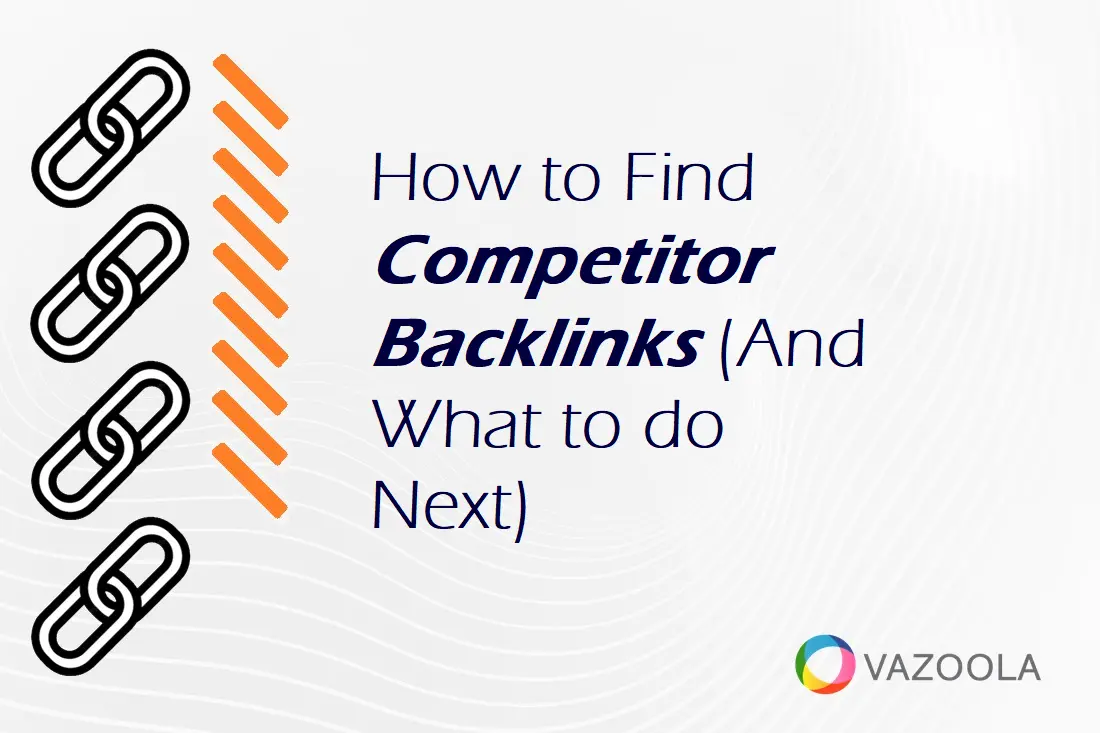
Here at Vazoola, we routinely conduct competitive analysis for our clients and understand the value of becoming familiar with competitor backlink profiles.
Performing this competitor analysis is a great link building strategy that you can employ on your own.
There's lots of advice out there about securing competitor backlinks. However, we're about to unpack the methods that have been refined and proven successful over the years.
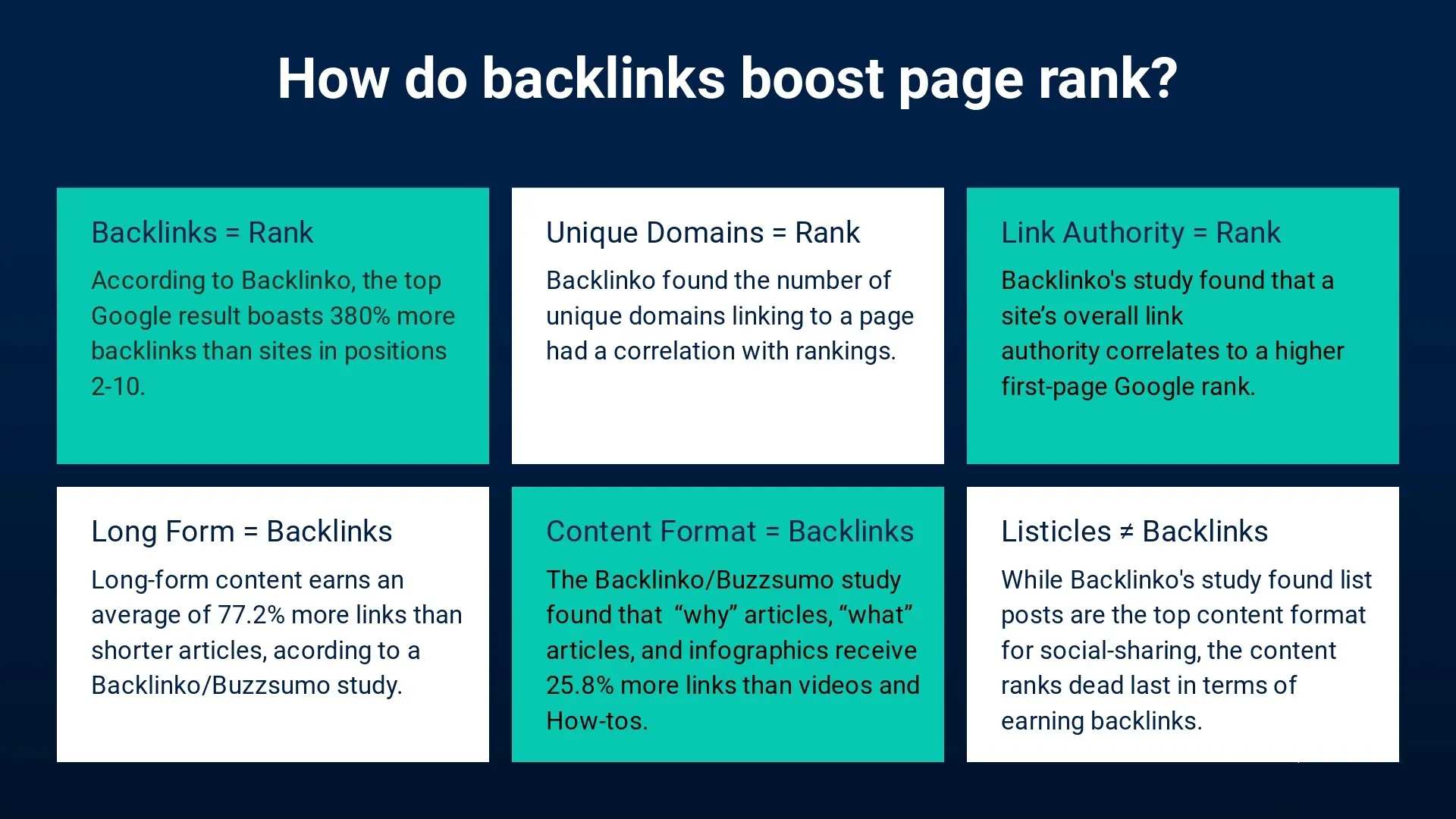
Of course, backlinks boost Google rankings, as demonstrated by the findings from Backlinko and Buzzsumo studies above. Acquiring them, therefore, is a vital aspect of SEO.
Still, link building for your own website can be a herculean task, especially when scouting for white hat backlinks. But, a smart approach? Look at the backlink profiles of top-ranking competitors' sites.
Why strive to reinvent the wheel when you can leverage what’s already working for others?
Let's dive right into the steps to capitalize on these inbound links. Then we'll take a deeper look into methods for acquiring each type of competitor link.
Key Takeaways
-
Competitor backlink analysis means diving deep into the external backlinks directing to a competitor's site. It sheds light on the strategies and sources fueling their SEO success. The essence of competitor backlinking revolves around earning links from the same websites as your competitors to improve your own online traction.
-
Competitor link analysis is crucial as it enables businesses to uncover the backlink strategies that give competitors a digital edge. The insights derived can guide decisions on where to focus back link-building efforts, saving time and resources while maximizing ROI.
-
The steps to gain competitor backlinks include:
-
Identifying your competitors
-
Analyzing their backlinks
-
Building a list to target
-
Executing on your list
-
-
Backlink strategy methods include a variety of methods, including identifying competitors links, analyzing listicles, evaluating competitor guest posts, hunting for broken links, referencing high authority backlinks and more.
Table of Contents
What Is Competitor Backlink Analysis?
Digital marketing is an intricate realm, but one SEO strategy often remains ensconced in shadows, even though it holds the potential to revolutionize your online visibility—competitor backlink analysis.
SEO can often be overwhelming, with many valuable tactics and strategies getting missed and overlooked. Competitor backlink analysis is one of those tactics.
This SEO competitor analysis aims as uncovering the map of external links pointing to your competitor's domain.
These external links, or backlinks, are indicators of trust, relevance, and authority in the vast, interconnected world of the internet.
When a website links to another, it's not just about navigation—it's a stamp of approval, a nod, a gesture that says, "this content is worth your time."
When multiple reputable sites send backlinks to a single domain, a search engine like Google takes note. It's an affirmation that the content on the destination website is valuable, and hence, it deserves a higher ranking in search results.
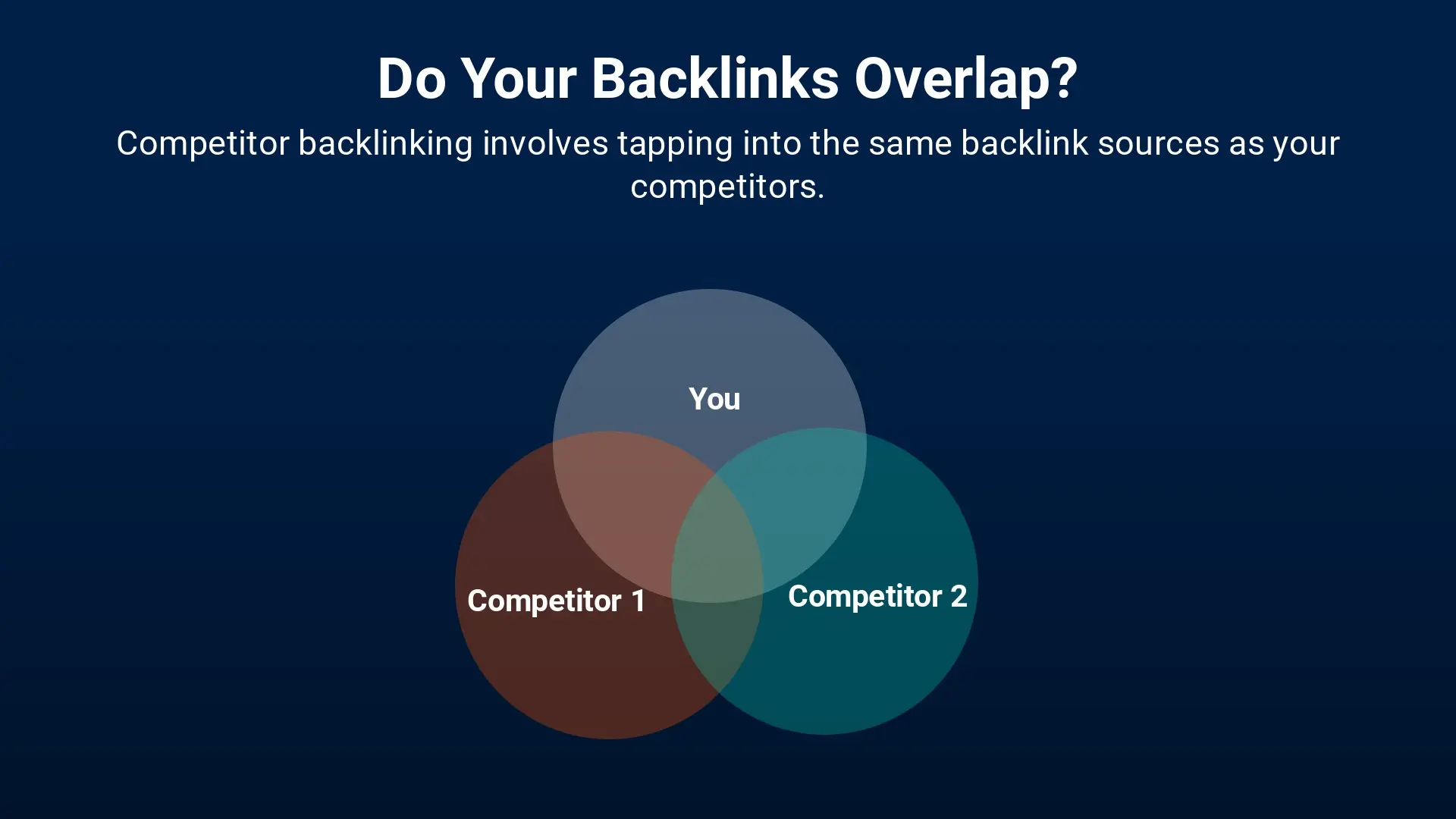
The analysis of backlink competitors allows businesses to meticulously dissect where their competitors are getting these stamps of approval.
Are they from industry authorities? Popular blogs? Forums?
Knowing the sources of these other links offers invaluable insights. It unveils the content strategies competitors are employing to build links, the audiences with whom they're engaging, and the channels they're using to amplify their reach.
Furthermore, the analysis doesn’t just stop at backlink quantity. After all, not all backlinks are created equal. The quality, relevance, and context of these backlinks matter.
Two competitors might have an equal number of backlinks, but if one has more backlinks from high-authority, relevant domains, they'll undoubtedly have the edge.
What is Competitor Backlinking?
If competitor backlink analysis is about understanding, competitor backlinking is about action. It's the tactical process of securing backlinks from the very sources that link to your competitors.
Imagine a scenario: Two companies, A and B, are vying for the top spot in the organic tea market. Company A discovers through analysis that a popular health blog has linked to Company B's article about the "Top 10 Benefits of Organic Tea."
Company A, recognizing the backlink opportunities, crafts an even more comprehensive, well-researched article on the "15 Science-backed Benefits of Organic Tea." It then approaches the same health blog, showcasing its superior, helpful content and securing a backlink.
This is competitor backlinking—stepping onto the same sites as your competitors but aiming to outshine them.
It's not just about mimicking their strategy but enhancing your own.
By leveraging their success, you're not copying; you're optimizing. You identify gaps in their relevant content, discover platforms they might have missed, and build relationships with domains they've already fostered connections with.
The beauty of competitor backlinking lies in its efficiency.
Instead of starting your link-building journey from scratch, you're getting a big head start. You already know which domains are open to linking content in your niche.
The challenge is to convince them that your content adds more value, and once you master that, the digital world is your oyster.
Why Is Competitor Backlink Analysis Important?
Businesses continually striving to mark their territories in the crowded digital landscape.
Amidst the bustling online marketplace, competitor backlink analysis emerges as a compass, guiding businesses toward the promised land of higher search engine rankings.
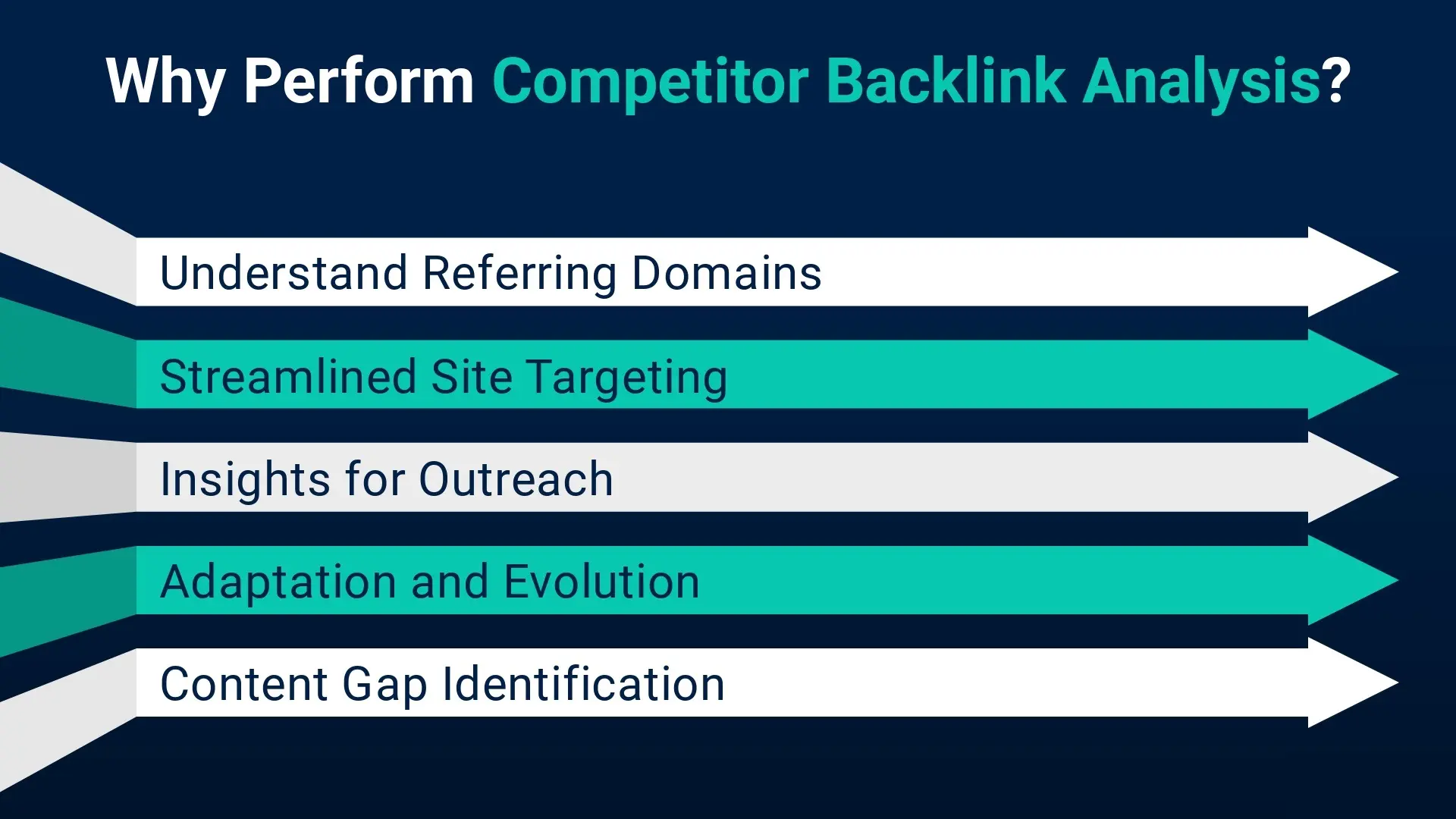
At its core, analyzing competitor backlinks isn't merely about playing catch-up or mimicry; it’s about gaining a strategic advantage.
Link analysis offers businesses the unique perspective of viewing their domain through the lens of external validation—understanding the digital handshakes their competitors have formed and leveraging this information to bolster their own position.
The analysis illuminates paths that might have been previously obscured, enabling brands to navigate with increased clarity and confidence.
But, you may wonder, why exactly does this method hold such significance? Let's examine its benefits:
-
Understanding Referring Domains: Referring domains pointing to your own site act as validation points. They're the external websites that have deemed your competitor's content valuable enough to link back to. Analyzing backlinks' domains can help ascertain which domains view your competitor as an authority, offering insights into potential partnerships for your business.
-
Streamlined Site Targeting: Targeting becomes less of a shot in the dark. With analysis of backlinks, businesses can easily identify websites willing to link to similar content. Doing so streamlines outreach efforts, ensuring time is spent on fruitful prospects for building backlinks.
-
Insights for Outreach: Effective outreach is informed outreach. By understanding the kind of content that earned your competitor a backlink, you can tailor your approach when reaching out to the same site. It offers a blueprint, detailing the type of content that resonates with specific domains.
-
Adaptation and Evolution: Strategies remain fluid and dynamic. By continually keeping an eye on competitor backlinks, businesses can adapt their link-building strategies based on what's working for the competition, ensuring they remain relevant and ahead of the curve.
-
Content Gap Identification: Content gaps transform into link opportunities. By noting the kind of content that earns competitors backlinks, businesses can identify gaps in their own content strategy, ensuring they cover topics that appeal to both readers and referring domains.
In essence, analysis of competitor backlinks is not a mere luxury—it's an indispensable tool.
In the digital marketing game, it offers businesses a glimpse into their competitor's moves, allowing them to strategize, counteract, and, most importantly, stay several moves ahead.
How to Gain Competitor's Backlinks (4 Steps)
If you’re still reading, it's clear you recognize the unparalleled potential that lies in effectively leveraging each competitor's link profile to catapult your SEO success.
The thought of tapping into the backlinking strategies of your competitors can seem like unearthing a treasure trove of SEO backlink opportunities.
But, to wield this power, you must first understand the lay of the land, starting with identifying who you’re up against in the digital battleground. SEO professionals or link building services offer help with this task, but we've lay out all the details so you can take charge of your own link building.
1. Identify Competitors
In the world of SEO, understanding both your domain and page-level competitors is essential.
While a domain-level competitor might be battling you for overall digital dominance, a page-level competitor might just be contesting a specific target keyword or topic.
A domain level competitor is one that competes with you on a broader scale, targeting many of the same keywords site wide. On the other hand, a page level competitor is not as closely related to your website on the whole, but happens to be ranking well for a similar page on your website.
Grasping this differentiation is the cornerstone of an effective link building strategy.
Pro Tip:
Track how rapidly your competitors are gaining or losing backlinks. A sudden surge in their backlink count might indicate a successful campaign or a possible collaboration. Conversely, a rapid decrease might hint at lost partnerships or Google penalizing them for unnatural link-building practices.

Use Tools to Find Competitors
In the vast abyss of digital marketing, a backlink analysis tool acts as your torchlight, illuminating the path ahead.
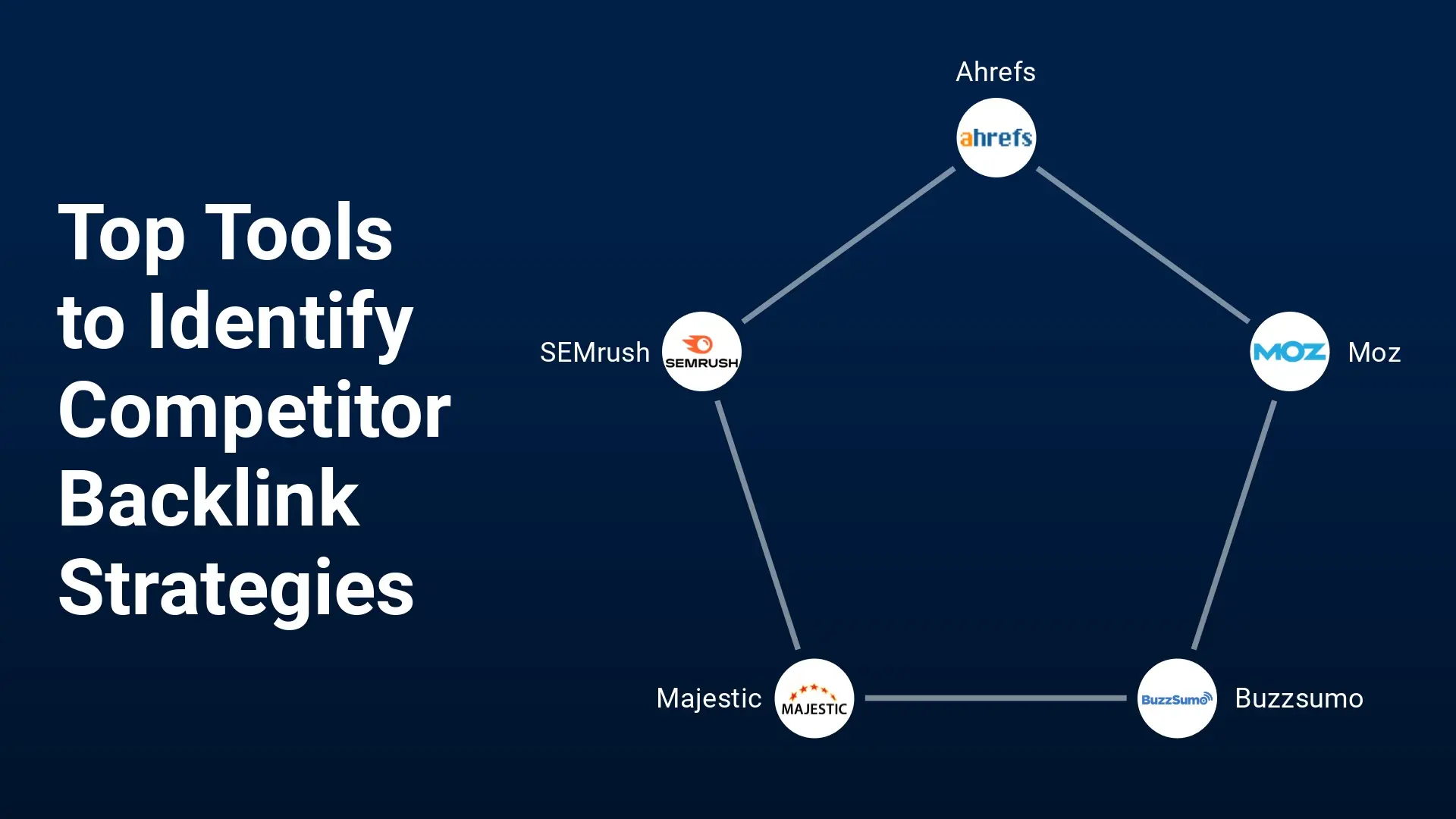
By employing the right set of tools, you easily can unveil the strategies that your competitors employ and craft a more refined plan of action for yourself.
Some of the must-have tools in your arsenal include:
-
Ahrefs: A leading tool in analyzing backlinks, Ahrefs offers an extensive database of backlinks and provides insights into the linking domains, anchors, and top pages with the exact URL of your competitor's website.
-
Moz: An all-in-one suite for SEO enthusiasts, Moz offers tools like Link Explorer to give a comprehensive view of your competitors' linking strategies and their domain authority.
-
SEMrush: A multifaceted tool, SEMrush provides detailed reports on competitors' backlink profiles, allowing you to study their strategies and identify gaps in your own approach.
-
Majestic: Pioneers in link intelligence, Majestic helps you understand the link profile of any domain, offering insights into trust flow, citation flow, and a host of other critical metrics.
-
BuzzSumo: Essential for content-driven insights, BuzzSumo lets you see the most shared content for a topic or from a domain. This can help identify key areas your competitors are gaining traction in.
Startup SEO toolkit:
— Brian Bourque (@bbourque) June 29, 2022
• Google Analytics >> traffic
• Google Search Console >> rankings
• SEM Rush >> competitor research
• Ahrefs >> backlink analysis
• Screaming Frog >> technical SEO
Keyword-driven Competitor Identification
The art of identifying competitors based on keywords is two-pronged, with strategies varying based on the maturity of your website's SEO.
New Websites
For websites with little to no SEO strategy, first conduct keyword research. This process will help you identify competitors. We typically offer this roadmap to clients who are looking to do keyword research with a simple spreadsheet for their own websites:
-
Brainstorm a list of high level topics relevant to your business
-
Add specific high level keywords that resonate with each topic
-
Use a free keyword research tool to expand your list of keywords
-
Finally, prioritize your list of keywords in each topic by finding high volume, low difficulty terms
Once you have a solid list of keywords to reference, start with very high volume keywords that are core to your business, and search them in Google. Browsing these results are a great way to find websites that compete directly with you. Repeat this process for several of your best keywords, compiling a list of competitor websites along the way.
Established Websites
For the commanders of seasoned websites with entrenched SEO strategies, the process becomes more granular.
The focus shifts from broad topics to the standout pages of the website—the ones that bring in traffic, conversions, and accolades.
By zeroing in on these pages, one can distill the keyword research that these champions are optimized for.
By zeroing in on these pages you can easily find competitors who compete most directly with you by taking your most valuable keywords and searching them in Google directly. From here, you also will browse the results and compile a list of direct competitors.
A comprehensive spreadsheet detailing these prime keywords, coupled with the top domain and page level competitors competitors for each, acts as the roadmap.
A deep dive into search results for other keywords reveals the direct competitors, giving you a clearer picture of the battlefield.
2. Analyze Competitors Backlinks with SEO Tools
Now you have a solid list of competitors to use as a starting point. The next step in in the process of gaining competitor backlinks is to determine which backlinks from your competitors profiles are worth targeting. Every SEO enthusiast faces a pivotal decision point: whether to invest in a free tool or take the leap into the world of premium, paid tools.
The distinction, at its core, lies in the depth and breadth of insights offered.
Think of SEO tools as telescopic lenses; while both can give you a view of the stars (or in this case, backlinks), the level of detail and clarity varies considerably.
Free tools offer a glimpse, enough to get you started on your backlinking journey. They often provide basic details, allowing you to identify some linking domains and perhaps a few top backlinks.
However, they might lack the in-depth analytical capabilities or expansive databases that their paid counterparts boast.
On the other hand, paid tools immerse you in a sea of data.
Not only can they drill down to the minutest details of every backlink, but they also provide analytical insights, trends, and patterns, which can be invaluable for devising a comprehensive backlink strategy.
The essence of these tools is to provide a window into the world of domains that have formed allegiances with your competitors, especially those that have forged bonds with multiple adversaries.
Pro Tip:
Always keep a keen eye out for domains linking to a multiple of your competitors. Such domains are much more likely to convert into a backlink when you reach out. They've shown an openness to your niche or industry, which provides a ripe opportunity for outreach.

Backlink Evaluation Criteria
As with any strategy, data-driven analysis is pivotal. However, the heart of your backlinking effort should pulse around the most recent acquisitions, the crème de la crème of backlinks, the precious do-follow ones, and the nuanced art of link placement. Below is a quick guide, but you can also check out our guide for more details on high quality backlinks.
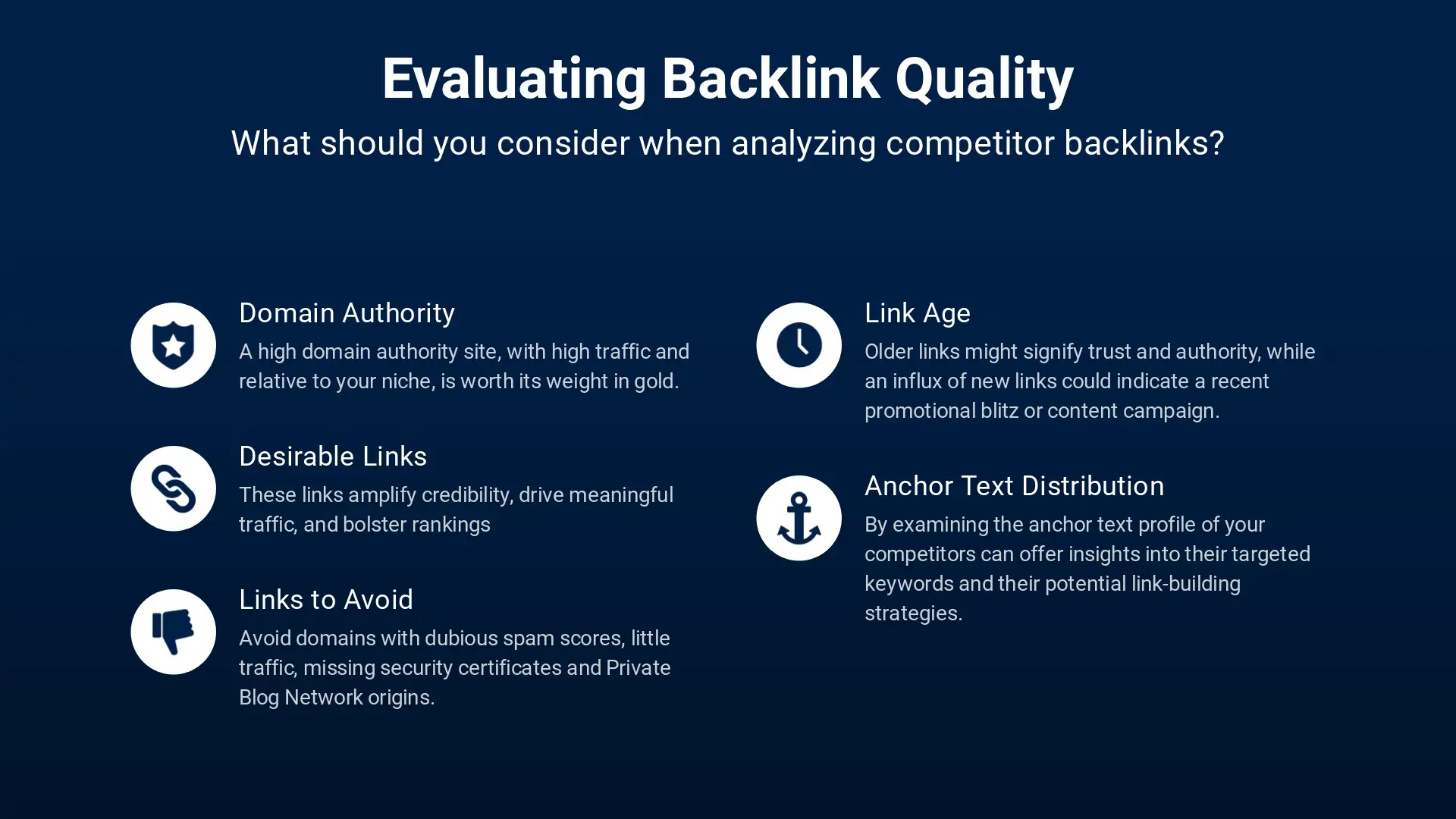
When charting these waters, the following ranking factors are paramount:
-
Domain Authority, Traffic, and Relevance: Just as lighthouses guide ships, these metrics act as guiding stars in the vast universe of backlinks. A high domain authority site, bustling with traffic and relevant to your niche, is worth its weight in gold.
-
Desirable Links: The realm of backlinking isn't merely about numbers; quality takes the front seat. Good links amplify credibility, drive meaningful traffic, and bolster rankings.
-
Links to Avoid: Navigating the backlink sea requires caution. Lurking beneath are treacherous domains marked by dubious. Websites with high spam scores, little-to-no traffic, missing security certificates, and poor internal linking are to be avoided. Among these include Private Blog Networks and link farms which are often some of the most toxic links possible.
-
Link Age: While fresh links often hog the limelight, understanding the age of your competitor's backlinks can reveal a pattern or strategy. Older, enduring links might signify trust and authority, while a flurry of new links could indicate a recent promotional blitz or content campaign.
-
Anchor Text Distribution: This metric sheds light on the diversity and strategy behind the linked phrases. By examining the anchor text profile of your competitors' backlinks, you can glean insights into their target keyword selections and their potential link-building strategies.
Pro Tip
When examining competitor backlinks, don't just look at the source and target pages. Dive deeper into the anchor texts being used to link to your competitor. These can offer insights into keyword strategies used by your competitor and highlight gaps in your own keyword usage, enabling you to craft more compelling and strategic content.

How do I see competitors backlinks?
Unearthing the backlink strategies of your competitors is akin to decoding their digital DNA. It provides invaluable insights into their strengths and weaknesses, revealing avenues for your own growth.
We've just given you a good framework for evaluating backlink quality and deciding which competitor backlinks to target and which to ignore. Many people ask at this point "how do I see competitors backlinks?".
Thankfully, several robust platforms offer tools for this purpose, allowing you to dive deep into your competitors' backlink profile and discover potential opportunities.
Beyond being our in-house favorite, the Vazoola Backlink Checker is a potent tool crafted with precision for link analysis. Not only does it furnish a comprehensive list of domains linking to your competitors, but it also offers granular details like link type, anchor text, and the context in which these links appear.
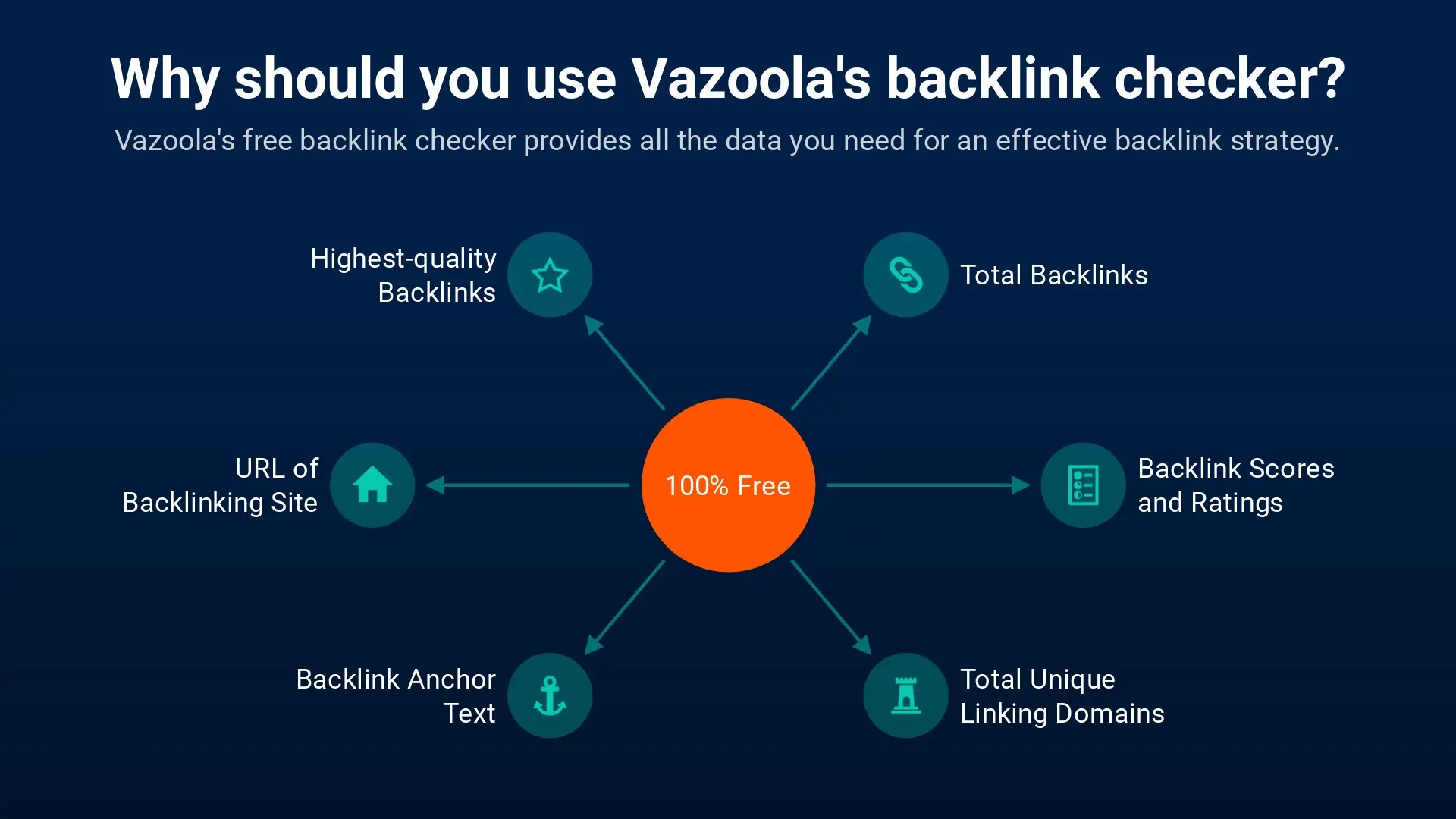
The next tools listed are paid tools that we use in house for finding competitors backlinks for our clients. Each tool below serves as a backlink checker and will show you a full list of backlinks and referring domains to any target website. They also all have a "link gap" feature that quickly identifies the backlinks that are pointing to your competitors sites but not yours.
These tools make it possible to successfully run a competitive link building campaign on your own!
A few options we recommend are:
-
Ahrefs Link Site Explorer: Ahrefs has long been a titan in the SEO tool realm, and its Link Intersect Tool upholds this legacy. You quickly can identify domains that link to several of your competitors but not to you, making it easier to spot missed opportunities.
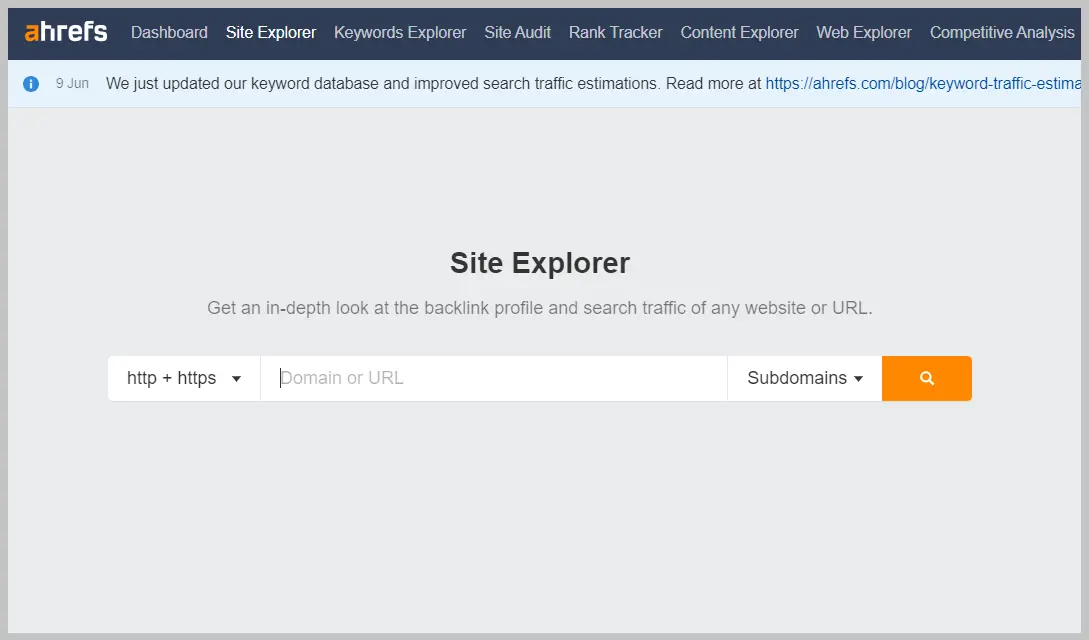
-
Moz Link Explorer: Think of Moz Link Explorer offers a panoramic view of your competitor’s entire link landscape. With metrics like Domain Authority and Page Authority at its core, it allows users to gauge the quality and potential impact of every backlink.
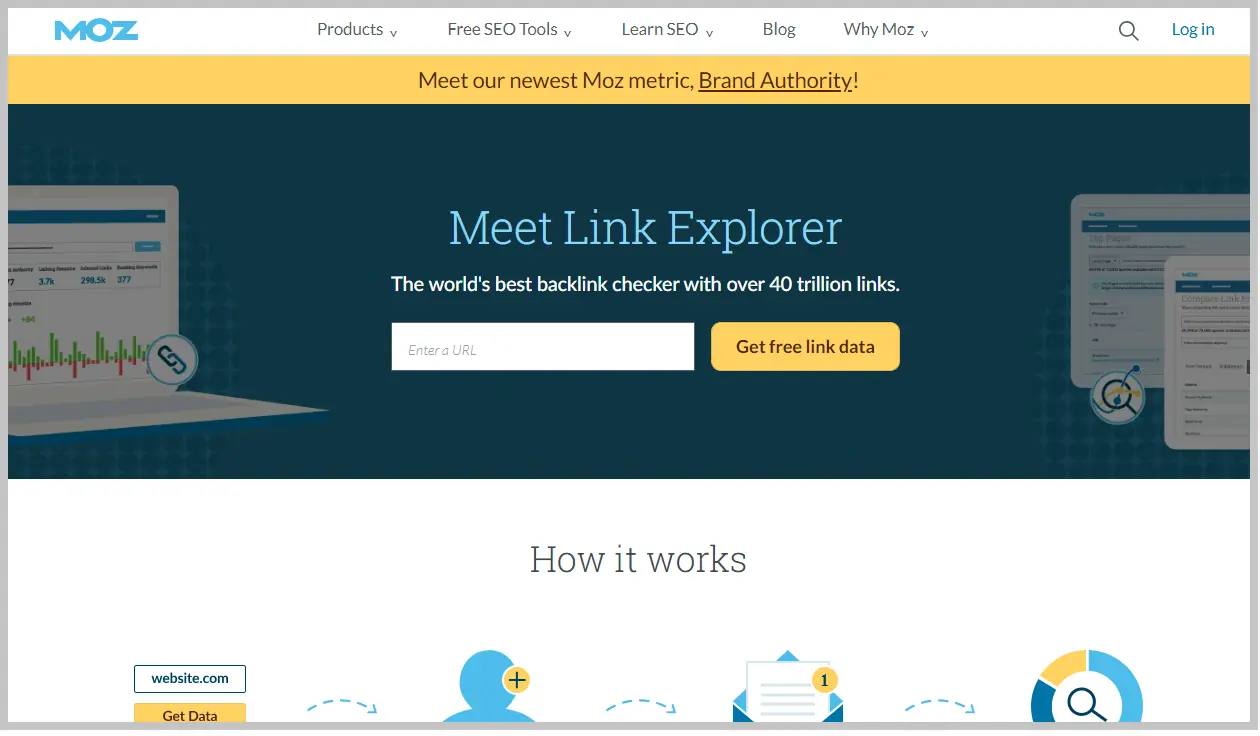
-
SEMrush Backlink Analytics: The name says it all. SEMrush's Backlink Gap tool is designed to highlight the chasm between you and your competitors in the backlink marathon. It's not just about numbers; it’s about quality and potential. This tool lays bare the areas where you're trailing, as well as the niches where you're leading.
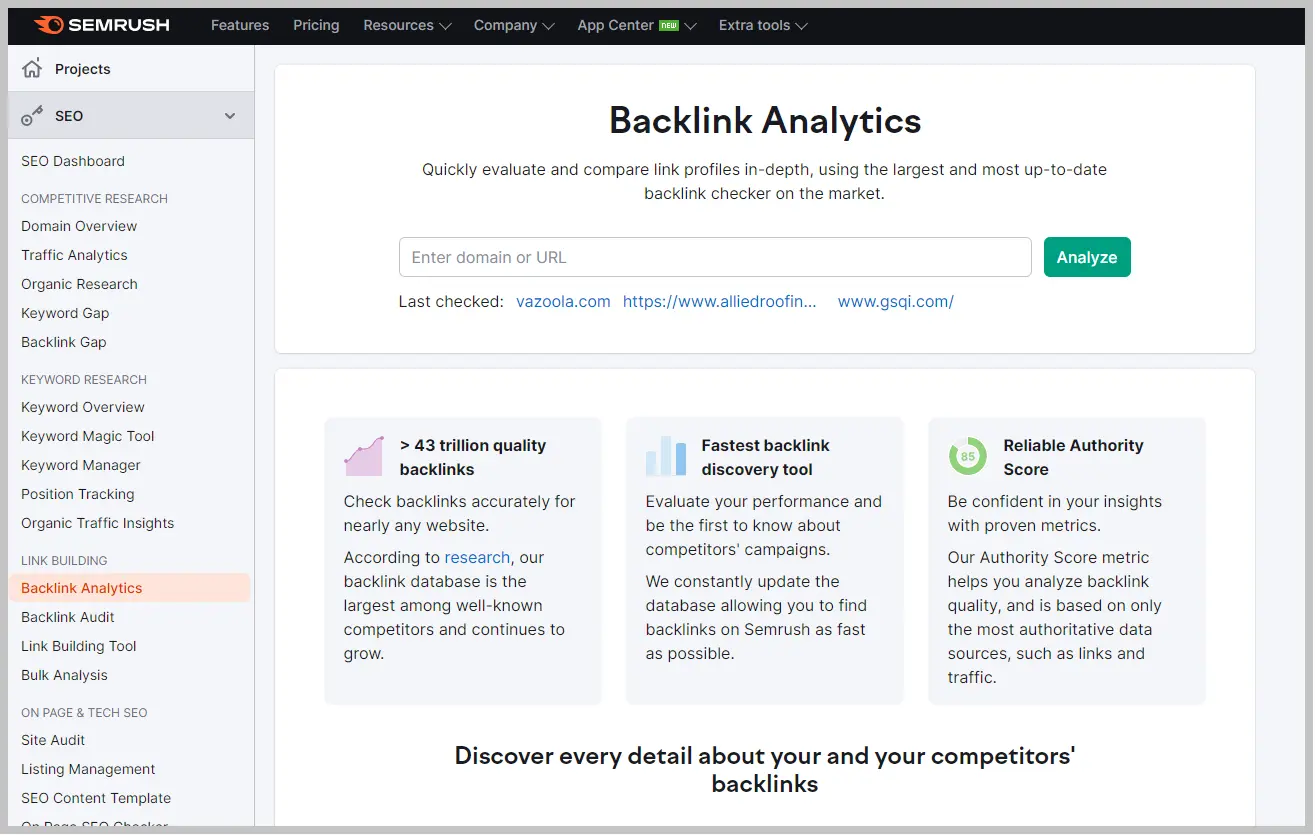
3. Build a List to Target
Embarking on a backlink quest without a well-structured game plan is akin to hiking through the wilderness without a compass.
The vast digital jungle easily can become overwhelming.
When you start pulling lists of competitors backlinks from your tools of choice, you'll realize how overwhelming the amount of data can be.
Thus, creating an organized list of domains to target becomes not just a recommendation, but a necessity. As mentioned above, the goal is to find high value backlinks from your competitors profiles.
Pro Tip
Pay special attention to the dofollow backlinks that your competitors have newly woven into their web. The fresher these links, the brighter they shine, hinting at active and responsive domains, thus elevating their conversion potential.

Tools like Google Sheets, with its intuitive and collaborative features, or specialized platforms tailored for backlink management can be instrumental in maintaining clarity amidst the complexities of link building.
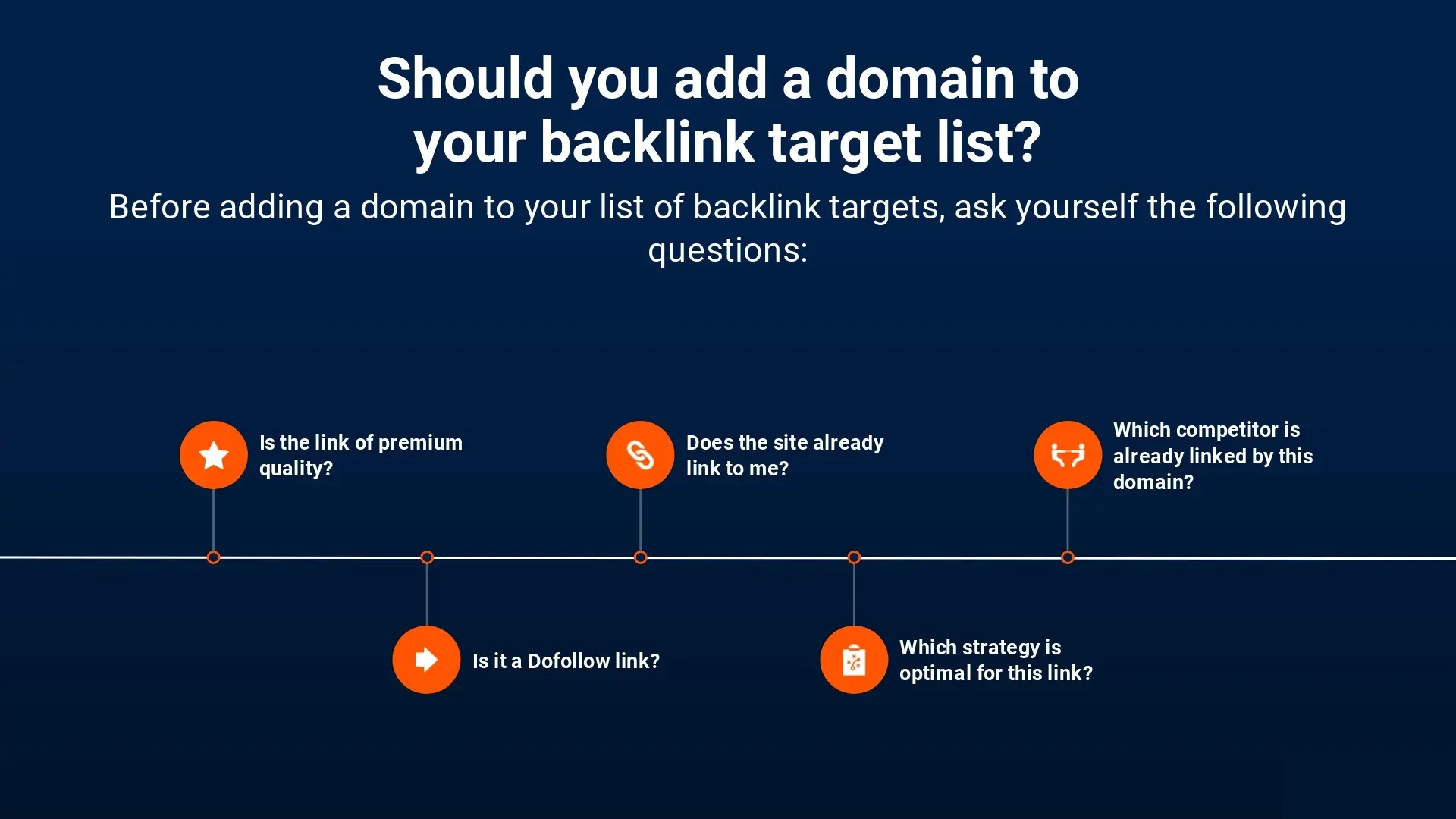
As you meticulously chart out this map, ask yourself several pivotal questions about each potential link:
-
Is the link premium quality? High quality backlinks trump quantity any day. Instead of amassing a plethora of links, focus on securing backlinks that are authentic, authoritative, and add genuine value to your SEO. High-quality backlinks from sites with a high domain authority not only elevate your domain authority but also foster trust among your visitors.
-
Is it a Dofollow link? "Dofollow" links are the gold standard in the realm of backlinks. Search engines recognize and reward these, making them invaluable for SEO. Prioritize these over "Nofollow" links, which, while beneficial in certain contexts, don't hold the same SEO weight.
-
Does this site already link to me? Redundancy is a pitfall to avoid. Before expending resources to secure a backlink, verify if the domain has already linked to your own site. If it has, skip this one because the first backlink from a domain is always significantly more valuable than the second and any subsequent.
-
Which strategy is optimal for this link? Every link is a unique entity, demanding a bespoke approach. Depending on its source—be it a blog post, forum, news site, or any other platform—craft a tailored strategy. Whether it's a guest post, creating a linkable asset, an influencer collaboration, or simply reaching out, ensure your approach aligns with the nature of the potential backlink.
-
Which competitor is already linked by this domain? Knowledge is power. Identifying which of your competitors already enjoys a backlink from a particular domain can offer invaluable insights.
Pro Tip
While it's tempting to focus solely on high-authority backlinks, a diverse backlink profile mimicking natural growth can be more beneficial. Seek competitor links for a balance of nofollow and dofollow, as well as a mix of directory links, guest posts, branded mentions, and more, to paint a comprehensive backlink landscape.

As you consider the above questions, organize your spreadsheet so that common targets are grouped together. This will make it the next step easier!
Some good headers to track on your spreadsheet include:
-
anchor text
-
linking URL
-
competitor
-
domain authority (of competitor backlink)
-
domain traffic (of competitor backlink)
-
date competitor acquired link
-
type of link placement
As you browse your lists of competitors backlinks, carefully pick and choose ones to target, adding them to your spreadsheet accordingly. Feel free to get creative and track other data points as well!
4. Execute on Your List
The meticulous effort you've invested in crafting your list now demands action. Stepping into the execution phase is akin to embarking on a tactical mission: It's all about precision, persistence, and a robust strategy.
Backlink Strategy Execution
Every link on your list represents a unique challenge and opportunity.
While some may require a straightforward blogger outreach approach, others might necessitate a more tailored strategy.
For instance, links from renowned industry blogs may require crafting a compelling guest post pitch, while reclaiming broken links may involve a more technical approach.
Understanding the Landscape
It's crucial to have a grasp of the terrain you're stepping into. Every domain you target has its ethos, audience, and requirements.
Before reaching out, invest time in understanding the website's content, audience, and tone. This effort ensures that your outreach is resonant and in line with their values.
Quality Over Quantity
While it might be tempting to send out a barrage of emails or requests, quality trumps quantity in the world of backlink acquisition.
Personalize your pitches, offer tangible value, and highlight mutual benefits. Remember, every interaction is an opportunity to forge a relationship, not just secure a link.
Adapting Your Own Link Building Strategy
The digital realm is a dynamic one. Expect rejections, non-responses, and sometimes, enthusiastic affirmatives.
It's essential to remain adaptable. Modify your strategies based on feedback, be willing to negotiate, and always be on the lookout for emerging opportunities.
Leveraging Relationships
If you've previously established connections in your industry, now is the time to leverage them. Personal introductions or endorsements can significantly boost your outreach's success rate.
Once you secure a backlink, nurture that relationship. Today's backlink provider can be tomorrow's strategic partner.
Pro Tip
Instead of purely focusing on gaining a backlink, prioritize fostering genuine relationships with industry influencers, bloggers, and domain owners. This can lead to more organic mentions, collaborations, and a sustained backlink growth that's resilient to algorithm changes.

How to Find Competitor Backlinks
This section will focus specifically on useful tactics for acquiring competitor backlinks. In the world of SEO, understanding and replicating the backlink success of industry leaders can significantly propel a brand's digital visibility.
The 1-4 framework laid out above will apply generally to each of these methods below. But how do you find competitor backlinks?
Fortunately, we've put together an extensive guide on specific ways to find competitor backlinks so that you can add then to your own profile.
1. Find the Highest Authority Backlinks
High-authority incoming links provide a significant SEO boost and are a great place to start when you are looking to gain backlinks from your competitors because they offer the best ROI.
Our recommendation: use SEM rush to pull a list of your competitors referring domains and then sort the list by Domain Authority. Then so a separate sort for highest traffic. This will help you quickly identify your competitors best backlinks.
2. Identify Directory Links and Profile Links
Directory and profile links provide foundational support in any backlink profile, improving your referral traffic.
These links are part of a well rounded and high quality backlink profile, even thought they probably won't move the needle too much on your rankings. Google still likes to know that you are a real entity, and directly links help to do this.
Our recommendation: use SEMrush or similar tool to view a competitors full list of backlinks, then filter to see referring page URLs that include your competitors brand name. These results are often the profile and directory backlinks. Browse each result to be sure!
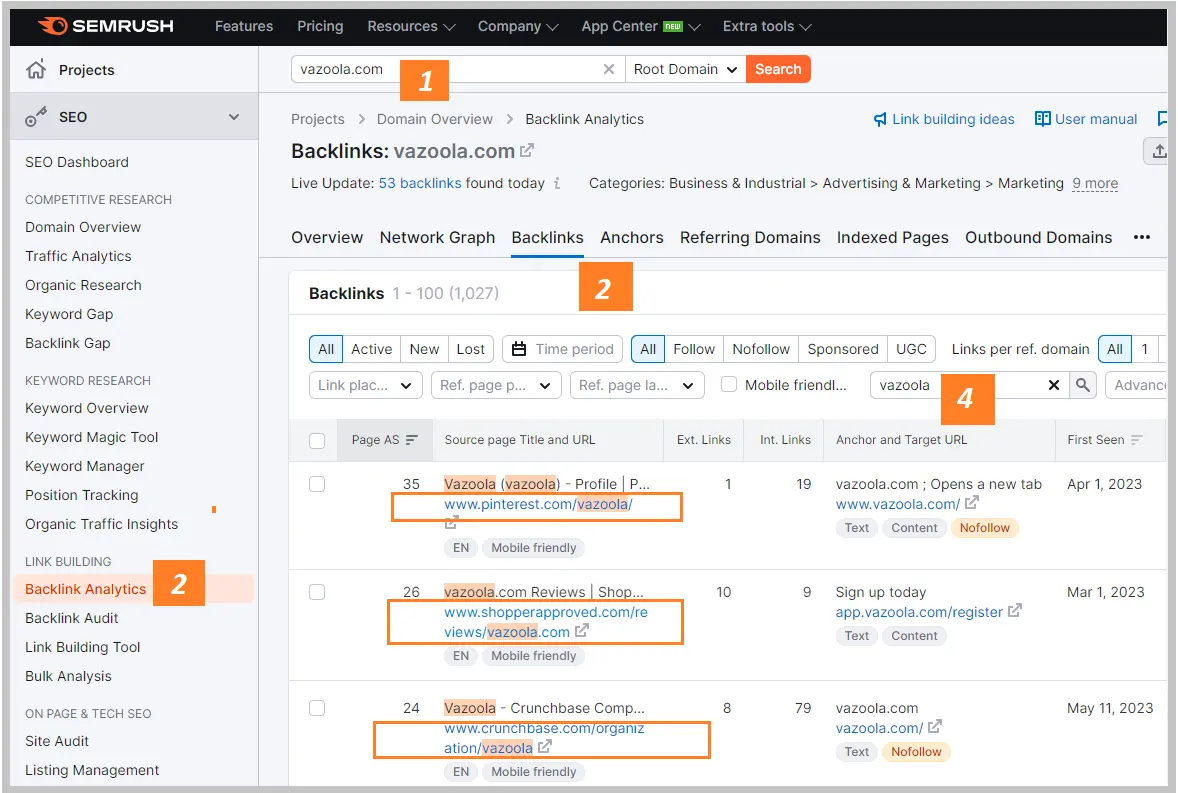
3. View Competitor Branded Home Page Links
Branded links directly enhance brand visibility and credibility. Scan SEO tool backlink reports for branded anchors—those directly referencing your competitor’s brand name—that direct to their homepage.
Our recommendation: Export a list of backlinks from one of your competitors into a spreadsheet. Then sort the column that shows which page on your competitors site the backlink points to. Scroll down until your find your competitors home page URL to easily see all of the home page links in one place.
4. Evaluate Competitor Guest Posts
Guest posts are a staple in building domain authority. Identify where your competitors are actively contributing. Doing so can provide insights into potential platforms receptive to industry-specific content. You can also gauge what content resonates with those audiences.
Our recommendation: To find competitor guests posts you'll need to do some investigating. Choose a competitor website and browse the about us or team page to find the marketers, writers, or contributors. You can search Google for content written by them by searching queries like "Author Name + articles". From here you can browse the results to find the websites your competitor has written content for.
Another way to do this is using Ahrefs Content Explorer. Take the name of the author you've found and use add it to the search box, making sure "everywhere" is selected. Then take a look at the list of articles that gets returned and look for relevant sites with high domain ratings. Be sure to exclude any result that is from your competitors site directly.

With both of these methods, the outreach to the target website will be the same. Try to get in touch with someone from marketing, SEO, or PR to ask about their guest post policy.
5. Use the Skyscraper Method
The skyscraper technique is about improving upon existing popular content and promoting it. With Ahrefs, you can spot competitor pages amassing more backlinks. The goal is to produce even better content and then approach the domains linking to your competitors.
Our recommendation: use a combination of Ahrefs Best by links report and Top pages report. Both of these reports will allow you to see which of your competitors pages are performing the best in terms of backlinks or traffic.
Why does it matter? Because it allows you to easily identify the specific pieces of content that perform well for them so you can do it even better using the skyscraper method. Once your new piece of content is up you're likely to attract similar backlinks to your competitors.
6. Search for Listicle and Top 10 Articles
Listicles and Top 10 articles often amass shared, traffic, and backlinks. More importantly, if you're competitors are listed in these types of pieces, you want to be there as well.
Our recommendation: A great strategy is to find competitors listed in relevant listicles and then reach out directly to each publishing website to see what it takes to get yourself listed and linked!
7. Seek Broken and Lost Links
Broken links can be a strategic inroad for backlink acquisition. Tracking these down for your competitors websites is a great opportunity to reach out to those domains, suggesting they replace the broken link with a relevant link to your site. If you don't already have a relevant page, you may find its worth creating one before you do your outreach.
Our recommendation: Use Ahrefs to find competitors pages that are not loading. Enter your competitors site in to Ahrefs Site Explorer and choose the Broken backlinks report. Be sure to select dofollow option to see the most relevant results.
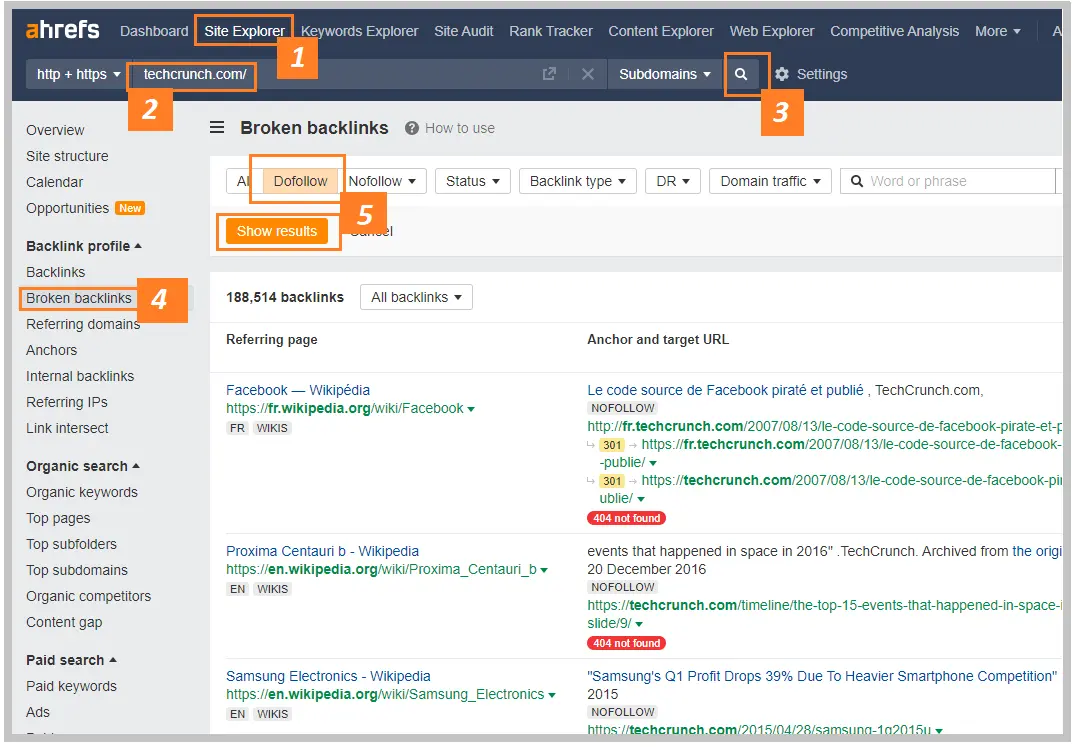
8. Close the Link Gap
Link gap is simply a term that refers to all of the backlinks pointing to your competitors but not your own site. As mentioned above, many SEO tools have a feature that directly addresses the link gap problem. Each tool names their tool a little differently but the all do something very similar.
Ahrefs and Moz call it Link intersect while SEMrush calls is Backlink Gap.
Our recommendation: Choose a link gap tool and enter two or more of your competitors along with your own domain. Then run the report and look at high quality backlinks that you can add to your backlink profile.
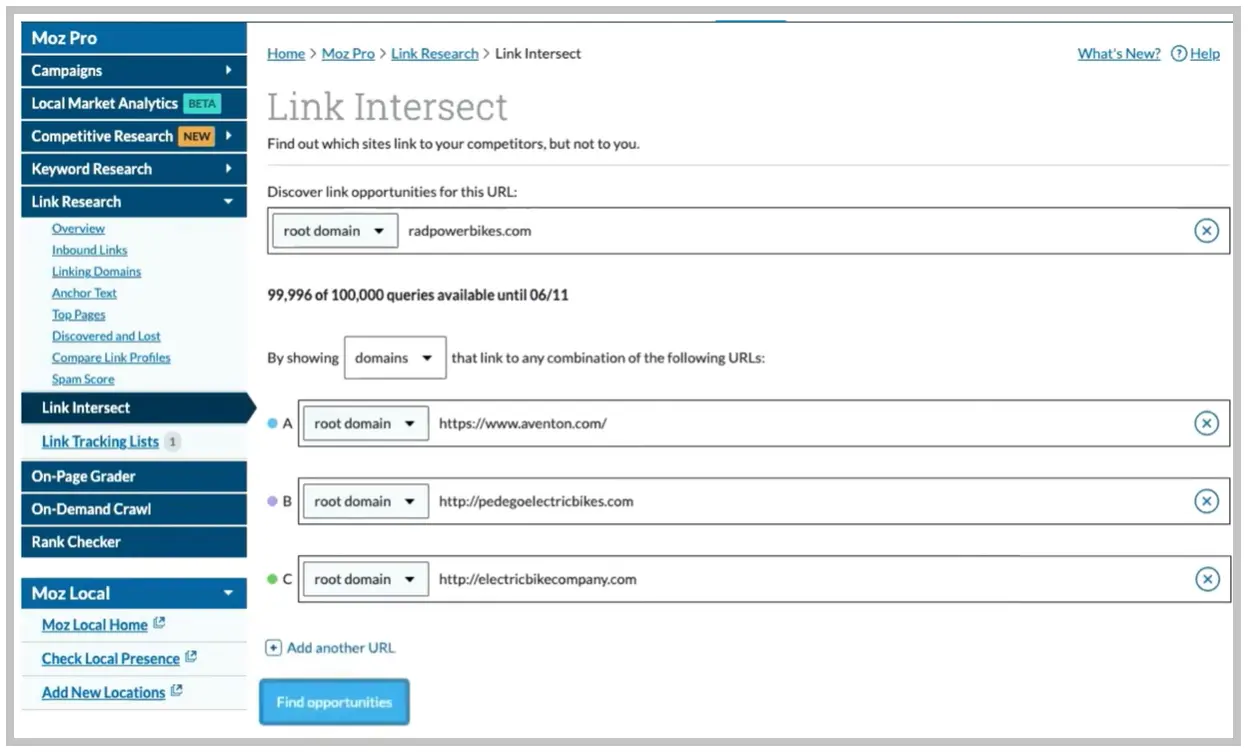
9. Look for Newest Backlinks and Brand Mentions
This last method is great for remaining competitive after a large up front effort has been made to capture as many of your competitors best backlinks as possible.
Staying updated with the latest backlinks and brand mentions can offer a competitive edge. Platforms like BuzzSumo send real-time alerts for brand mentions, making it easy to track competitor recognition. Meanwhile, Ahrefs excels at detecting the freshest backlinks, revealing recently secure opportunities to build backlinks.
Our recommendation: Use a platform like BuzzSumo to monitor and receive alerts for competitor brand mentions and new backlinks. Being able to target and capture your competitors latest activity is a great way to make sure you don't fall behind.
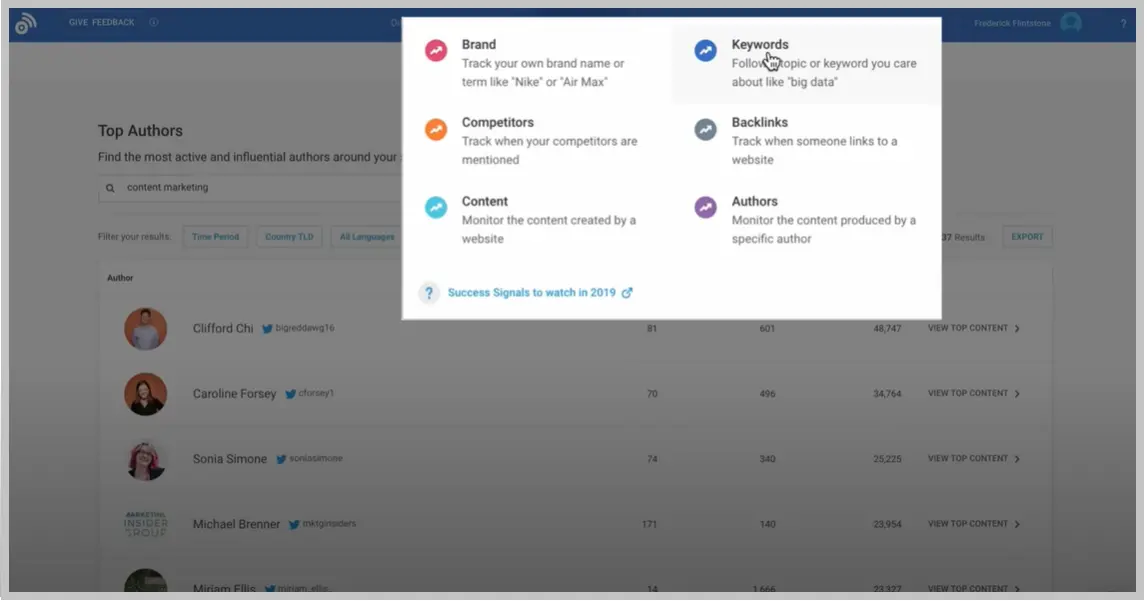
Wrapping Up
Navigating the maze of inbound links analysis and acquisition isn't just about uncovering secrets or mimicking competitors.
It's a strategic move to propel your brand to the forefront of the digital landscape, ensuring longevity and dominance in search rankings.
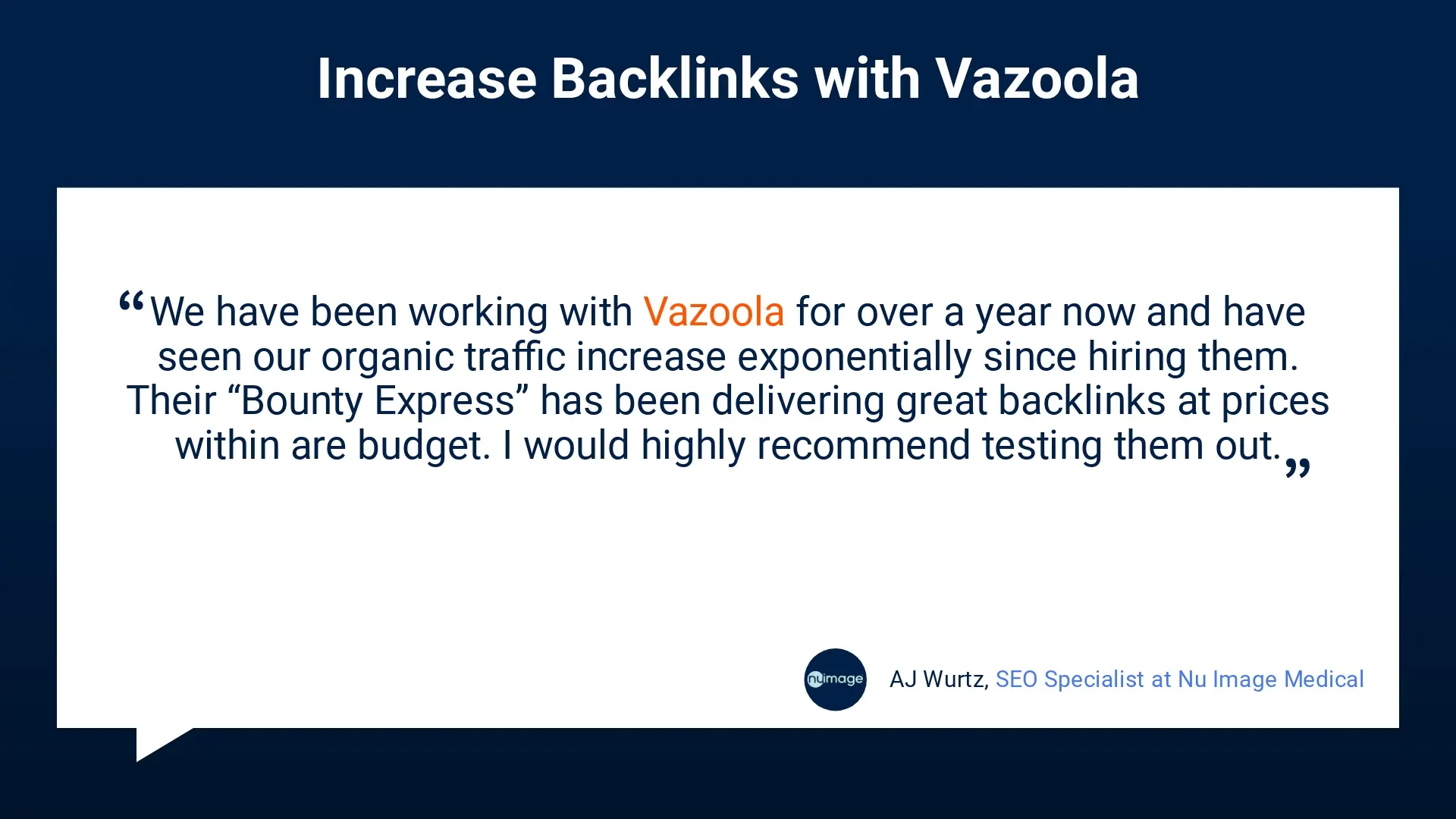
Start by identifying competitors, analyze their backlinks, choose which links to target and how, and then execute on your strategy. We've covered a number of tools, tips, and methods for getting the job done but as professional link builders we know how difficult the task can be which is why we're always here to lend a hand for those interested in buying backlinks.
Even so, we're sure you can find success and start building your backlink profile and improving your rankings.

